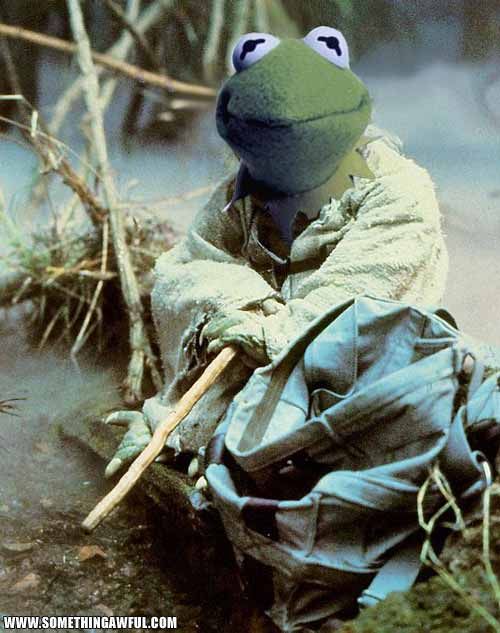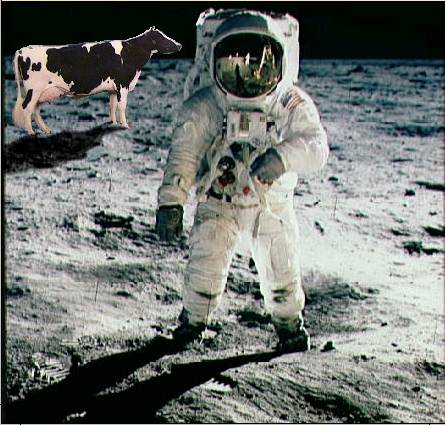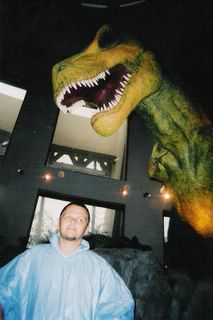Life on Mars?!
Exclusive: NASA Researchers Claim Evidence of Present Life on Mars
from Space.com
WASHINGTON - A pair of NASA scientists told a group of space officials at a private meeting here Sunday that they have found strong evidence that life may exist today on Mars, hidden away in caves and sustained by pockets of water.
 The scientists, Carol Stoker and Larry Lemke of NASA's Ames Research Center in Silicon Valley, told the group that they have submitted their findings to the journal Nature for publication in May, and their paper currently is being peer reviewed.
The scientists, Carol Stoker and Larry Lemke of NASA's Ames Research Center in Silicon Valley, told the group that they have submitted their findings to the journal Nature for publication in May, and their paper currently is being peer reviewed.
What Stoker and Lemke have found, according to several attendees of the private meeting, is not direct proof of life on Mars, but methane signatures and other signs of possible biological activity remarkably similar to those recently discovered in caves here on Earth.
Stoker and other researchers have long theorized that the Martian subsurface could harbor biological organisms that have developed unusual strategies for existing in extreme environments. That suspicion led Stoker and a team of U.S. and Spanish researchers in 2003 to southwestern Spain to search for subsurface life near the Rio Tinto river — so-called because of its reddish tint—the product of iron being dissolved in its highly acidic water.
Stoker told SPACE.com in 2003, weeks before leading the expedition to southwestern Spain, that by studying the very acidic Rio Tinto, she and other scientists hoped to characterize the potential for a chemical bioreactor in the subsurface - an underground microbial ecosystem of sorts that might well control the chemistry of the surface environment.
 Making such a discovery at Rio Tinto, Stoker said in 2003, would mean uncovering a new, previously uncharacterized metabolic strategy for living in the subsurface. For that reason, the search for life in the Rio Tinto is a good analog for searching for life on Mars, she said.
Making such a discovery at Rio Tinto, Stoker said in 2003, would mean uncovering a new, previously uncharacterized metabolic strategy for living in the subsurface. For that reason, the search for life in the Rio Tinto is a good analog for searching for life on Mars, she said.
Stoker told her private audience Sunday evening that by comparing discoveries made at Rio Tinto with data collected by ground-based telescopes and orbiting spacecraft, including the European Space Agency's Mars Express, she and Lemke have made a very a strong case that life exists below Mars' surface.
Stoker and Lemke's research could lead the search for Martian biology underground, where standing water would help account the curious methane signatures the two have been analyzing.
They are desperate to find out what could be producing the methane, one attendee told Space News. Their answer is drill, drill, drill.
 NASA has no firm plans for sending a drill-equipped lander to Mars, but the agency is planning to launch a powerful new rover in 2009 that could help shed additional light on Stoker and Lemke's intriguing findings. Dubbed the Mars Science Laboratory, the nuclear-powered rover will range farther than any of its predecessors and will be carrying an advanced mass spectrometer to sniff out methane with greater sensitivity than any instrument flown to date.
NASA has no firm plans for sending a drill-equipped lander to Mars, but the agency is planning to launch a powerful new rover in 2009 that could help shed additional light on Stoker and Lemke's intriguing findings. Dubbed the Mars Science Laboratory, the nuclear-powered rover will range farther than any of its predecessors and will be carrying an advanced mass spectrometer to sniff out methane with greater sensitivity than any instrument flown to date.
from Space.com
WASHINGTON - A pair of NASA scientists told a group of space officials at a private meeting here Sunday that they have found strong evidence that life may exist today on Mars, hidden away in caves and sustained by pockets of water.
 The scientists, Carol Stoker and Larry Lemke of NASA's Ames Research Center in Silicon Valley, told the group that they have submitted their findings to the journal Nature for publication in May, and their paper currently is being peer reviewed.
The scientists, Carol Stoker and Larry Lemke of NASA's Ames Research Center in Silicon Valley, told the group that they have submitted their findings to the journal Nature for publication in May, and their paper currently is being peer reviewed.What Stoker and Lemke have found, according to several attendees of the private meeting, is not direct proof of life on Mars, but methane signatures and other signs of possible biological activity remarkably similar to those recently discovered in caves here on Earth.
Stoker and other researchers have long theorized that the Martian subsurface could harbor biological organisms that have developed unusual strategies for existing in extreme environments. That suspicion led Stoker and a team of U.S. and Spanish researchers in 2003 to southwestern Spain to search for subsurface life near the Rio Tinto river — so-called because of its reddish tint—the product of iron being dissolved in its highly acidic water.
Stoker told SPACE.com in 2003, weeks before leading the expedition to southwestern Spain, that by studying the very acidic Rio Tinto, she and other scientists hoped to characterize the potential for a chemical bioreactor in the subsurface - an underground microbial ecosystem of sorts that might well control the chemistry of the surface environment.
 Making such a discovery at Rio Tinto, Stoker said in 2003, would mean uncovering a new, previously uncharacterized metabolic strategy for living in the subsurface. For that reason, the search for life in the Rio Tinto is a good analog for searching for life on Mars, she said.
Making such a discovery at Rio Tinto, Stoker said in 2003, would mean uncovering a new, previously uncharacterized metabolic strategy for living in the subsurface. For that reason, the search for life in the Rio Tinto is a good analog for searching for life on Mars, she said.Stoker told her private audience Sunday evening that by comparing discoveries made at Rio Tinto with data collected by ground-based telescopes and orbiting spacecraft, including the European Space Agency's Mars Express, she and Lemke have made a very a strong case that life exists below Mars' surface.
Stoker and Lemke's research could lead the search for Martian biology underground, where standing water would help account the curious methane signatures the two have been analyzing.
They are desperate to find out what could be producing the methane, one attendee told Space News. Their answer is drill, drill, drill.
 NASA has no firm plans for sending a drill-equipped lander to Mars, but the agency is planning to launch a powerful new rover in 2009 that could help shed additional light on Stoker and Lemke's intriguing findings. Dubbed the Mars Science Laboratory, the nuclear-powered rover will range farther than any of its predecessors and will be carrying an advanced mass spectrometer to sniff out methane with greater sensitivity than any instrument flown to date.
NASA has no firm plans for sending a drill-equipped lander to Mars, but the agency is planning to launch a powerful new rover in 2009 that could help shed additional light on Stoker and Lemke's intriguing findings. Dubbed the Mars Science Laboratory, the nuclear-powered rover will range farther than any of its predecessors and will be carrying an advanced mass spectrometer to sniff out methane with greater sensitivity than any instrument flown to date.







 what the Great Conjunction is. 'What's the Great Conjunction?'
what the Great Conjunction is. 'What's the Great Conjunction?' 




 A Is for Androids
A Is for Androids B Is for Boba
B Is for Boba C Is for Calvin
C Is for Calvin D Is for Dragons
D Is for Dragons E Is for Elric
E Is for Elric F Is for Futures
F Is for Futures G Is for Genie
G Is for Genie H Is for Hobbits
H Is for Hobbits I Is for Iceman
I Is for Iceman J Is for Jedi
J Is for Jedi K Is for Kraken
K Is for Kraken





































































0 Comments:
Post a Comment
<< Home